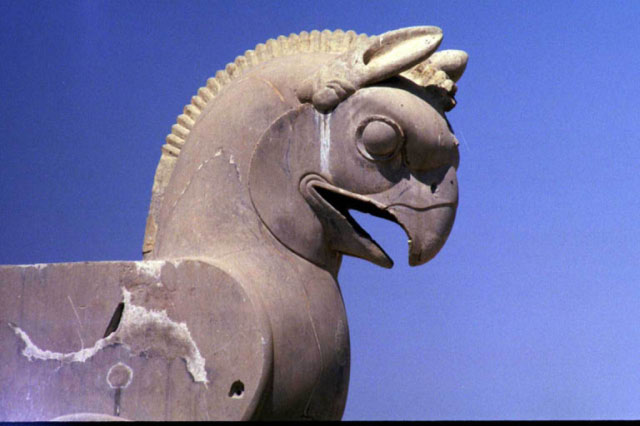|
World Peace Travel A Persian Journey -- The Spiritual Sites Tour (This tour is conducted in cooperation with the Join us as we tour one of the most fascinating destinations on earth. The ancient land of Persia has strong links with four different faiths—Zoroastrianism, Judaism, Christianity and Islam. Join us in this journey of faith as we explore the connections between these religions and this country. $2788 per person. The cost includes: All domestic air fare; all transfers and portages; three meals per day in Iran; sightseeing and entrance fees ; all hotel accommodations (based on double occupancy) motor coach and driver and all guide services. Single supplement $455. Not included: Airfare to Tehran; passport and visa fees, medical or cancellation insurance, gratuities and personal items For a day-by-day description of the itinerary click here. 28 April—Depart from gateway cities. 29 April—Arrive Tehran. Half day sight-seeing. 30 April—Early flight to Shiraz. Motorcoach to Persepolis, Naghsh-e-Rostam and Passagard. 1 May—Shiraz city tour. Late flight to Isfahan. 2 May—Isfahan City Tour 3 May—Shopping in Isfahan. 4 May—Motorcoach to Yazd. 5 May—Early flight to Tehran. Half day sight-seeing. 6 May—Motorcoach to Qom, Habbakuk’s tomb and Hamadan. 7 May—Esther and Mordecai’s tombs. Motorcoach to Tehran. 8 May—Final day in Tehran. 9 May--Departure Straight Talk About . . . Is that really a good idea? We all have seen the images on television of anti-Western, anti-American sentiment in Iran (and to be honest, you can still read about such sentiment in the newspapers in Iran) but the attitude of the people of Iran is much different than the policy of its government. I have dozens of personal examples; and the Americans we have escorted to Iran could provide dozens more. The Army colonel who brought pomegranates for our group when our motorcoach stopped for a bathroom break. The middle-aged man in the park in Isfahan, who, upon learning I was an American, shook my hand so vigorously I thought my shoulder would come out of its socket.
The 12-year-old girl in the small village of Izad-Khoist who invited our entire group (15 people) to her small adobe house for tea and grapes. The candy and fruit vendor in Shiraz who – when he learned I was an American – filled a sack full of dates and nuts and refused payment.
The hotel manager in Isfahan, upon learning we had some Southerners in our group, shouted: "Howdy Yall". (We don’t actually say "howdy" in the South, but the sentiment was genuine.) The wedding celebration we attended in Isfahan. (We refused the invitation a dozen times, but when we finally relented we were treated like rock stars at the reception and stayed until 1:30am)
Straight Talk About . . . Tourism in Iran First, some reality . . . the 5 star hotels in Iran are not really 5 star (these are ratings left from the 70’s but their glory has faded). An example: our room at the Kowsar Hotel in Isfahan was extremely spacious with a huge closet, ornate cornice board molding and heavy curtains that led to a balcony overlooking the Zayande’ River. However, the commode in the bathroom was three different shades of pink (it’s hard to get replacement parts in Iran) and that night when we went to bed, my wife and I noticed that the sheets for the king-sized bed were pieced together. Obviously, king-size sheets are in short supply. If these are the sorts of things that might ruin your vacation, read no further. (Find a spa. Get someone to rub mud and seaweed on you.) And for the lady travelers, there is the inconvenience of wearing the hejab, which is the general term describing the required covering of the head and body – it’s compulsory in Iran. And although some of our lady travelers said the custom saved time on hair preparation, the covering can be uncomfortable on warm days. However, the service in the hotels is wonderful, and the food in the restaurants is very good. The economic reality is this: the country has suffered greatly because of the U.S. embargo, particularly the tourism sector. And although there are still some elements in the Iranian government that would like to keep Americans out, a great segment of the population believe tourism can be a great asset to the economy. What does this mean? First it means that Iran is one of the great tourism values in the world. Fuel is cheap; labor is cheap; food is cheap – and that adds up to a great travel bargain (especially considering the strength of the dollar) for the U.S. tourist. And for the bargain hunter, the bazaars are full of values – carpets, gold, brass, handicrafts and antiques. We have developed some good relationships with trustworthy merchants there and can recommend them to you. One recurring odd experience that should be noted . . . because Iranian merchants are not allowed to accept credit cards from U.S. banks; payment must be arranged in some other manner. (One merchant in the Laleh Hotel in Tehran got around this restriction by calling his brother in San Francisco and had him accept our client’s credit card.) But the recurring experience was this: merchants would simply say: "You can send me payment later." In other words they would simply offer our clients the option of taking the merchandise (some of it expensive) and sending a form of payment later from the U.S. This was not an unusual experience for our clients, but it was a source of amazement to all of us that a merchant would offer such a level of trust. In summary, some parts of the tourism infrastructure in Iran are not well developed (and the great tragedy is that some of the sites that are two thousand years old are deteriorating because of lack of capital to keep them maintained) but the experience is magnificent. Perhaps Iran is not the best tourist destination for everyone -- but for traveler with some adventure in his blood, it is hard to surpass. Persia . . . the land of kings and poets. Join us. A Persian Journey—the Spiritual Sites Tour I saw a lion in the distance and I was afraid . . . but when he came closer I saw it was a man. When I came closer…I saw it was my brother. --Old Berber Proverb "The world is a book, and those who do not travel read only a page." --St. Augustine Days 1&2—Check your travel documents one last time and arrive at your gateway airport two hours before departure. Bring some reading material for the plane in case the in-flight movies are sub-par. We will arrive at Tehran’s Mehrbad Airport in the early morning hours. Plan to be surprised at how friendly everyone is at the airport as you go through passport control, claim your luggage, and pass through customs. As you exit the secure area of the airport you will be met by the King’s Travel Service representative, who will take you to the Laleh Hotel. You will pass by the impressive Azadi Monument on your way. A few hours sleep will be important. Jet lag is an unavoidable fellow traveler, so we will move slowly for the first half of the day. (If you are not able to sleep … the shops in the Laleh Hotel have some impressive items and the prices are not out of line with the bazaar.) We’ll take our lunch at the hotel and then visit the Archaeology Museum and the Crown Jewels Museum. At night we will enjoy a buffet dinner in the garden area outside the Laleh.
"Is it not passing brave to be a King, And ride triumphant through Persepolis?" --Christopher Marlowe in Tamburlaine Day 3—We’ll take the early flight to Shiraz and motorcoach to one of the most impressive sights of antiquity—Persepolis. Does every guidebook for Iran have a photo of Persepolis (more accurately called Takht-e-Jamshiid) on its cover? It seems so. And once you see it, you will understand its prominence. Darius I initiated the construction but the project wasn’t completed until 150 years later. A succession of Persian kings, including Xerxes (Ahaseurus in the Old Testament) intimidated vassal kings with the magnificence of Persepolis, and it is not unlikely that Esther, who saved the Jews in Persia, walked these hallways. Naghsh-e Rostam, the tomb of the kings, is less than 4 miles away. Hewn from a sheer cliff, the four tombs cut into the rocks, are reputed to hold the remains of Darius I, Artaxerxes, Xerxes and Darius II, but that’s one of the topics archaeologists like to argue about, so we’ll stay out of the debate and just admire the tombs. Also we’ll see as the reliefs that were cut into the rock several hundred years later during the Sassanian dynasty. And of particular interest to our Spiritual Sites Tour, we’ll inspect the Zoroastrian fire-temple from the Achaemenian era. (Robert Byron’s classic The Road to Oxiana is recommended reading prior to this day’s journey.) The last site of the day is Passagard and Cyrus the Great’s tomb. Little of Passagard remains for us to see, but the cenotaph of Cyrus is still intact, and no doubt we will hear the history (legend?) of why Alexander the Great spared this monument. True or not, it makes a great story. We will have earned our dinner and our rest this evening back in Shiraz after such a full day "The places I like best are the places that ask the best questions of me." --Pico Iyer Day 4—Shiraz, the place of poets, offers much for us to see, so we may have to ration the number of places we visit. Certainly we will include the Shah-e Cheragh Museum, and possibly the adjacent mosque. And we will include the Church of St. Simon the Zealot, who, according to local tradition, was married in Persia. Hafez and Saadi, the two most famous Persian poets, were both born in Shiraz, one of the most famous centers for learning and the arts, and we will visit their tombs. Plan to be surprised at the level of devotion still accorded these literary giants. A number of young women (and a few young men) will bring flowers and read their favorite Hafez passages (he wrote much about passionate love) around his tomb. If we’re not behind schedule, the attached garden with two pools is a wonderful place for a cup of tea and watching the locals smoke the hubble-bubble pipes. The Saadi tomb and its surroundings are not as impressive as the final resting place of Hafez, but we will pay our respects. Nassir Mosque will be of particular interest to our group because it has several tile representations of Christian churches! We’ll also visit Quran Gateway before we go to the airport to catch our flight to Isfahan.
"Isfahan has insinuated its image into that gallery of places which everyone privately treasures." --Lord Byron Day 5—"Isfahan nesf-e jahan"… "Isfahan is half the world" according to the ancient half-rhyme. You will be able to decide if you think it is an exaggeration. We will have two full days to explore this special city—but it will not be adequate. Emam Khomeini Square (still often referred to as Naghsh-e Jahan Square) will be our first destination. It was Shah Abbas’ polo grounds a few centuries ago but now serves as a huge courtyard which is ringed by mosques, palaces and the bazaar. We’ll visit Ali Ghapu Palace and climb 6 stories to capture the view previously enjoyed only by royalty. Then we’ll walk across the courtyard to see what many consider the most magnificent mosque in Iran—Masjed-e Emam. Completed in 1638, the image of its pale blue tiled dome finds itself featured significantly in travel brochures. It’s truly one of the most majestic mosques in the Muslim world. Also on the square is the smaller Lotfollah Mosque, which at one time was called the Women’s Mosque because there was a tunnel from the palace to the mosque, which allowed the women of the royal family to go to worship without being seen by the public. The bazaar around the square is extensive—Persian rugs, hand-printed tablecloths, metalwork (silver, brass and copper) are among the most interesting products. We’ll allow you time to bargain with the shopkeepers for that special souvenir. After dinner we may have the opportunity to take a cup of tea in one of the teahouses under one of the city’s bridges. There’s no better place in Iran than this for tea—as the waters of the Zayande River (usually only a few feet deep) run below our feet.
"Isfahan, where art majick was first hatched." --Sir Thomas Herbert, 1634. Day 6—Our second day in Isfahan will allow us to visit Vank Cathedral, one of the most interesting Christian edifices in Iran. Built in the mid-1600’s, there is an attached museum with a very impressive display of ancient Bibles and other documents, including what supposedly is the first book ever printed in Iran. Isfahan has an impressive string of bridges, some of which are more than 800 years old. We will take some time to investigate this ancient engineering. Also we will take a look at the Zoroastrian fire temple perched on a hill just outside of town. We will allow some unscheduled time in the afternoon to allow some rest… and just in case you would like to go back to the bazaar to purchase that item you saw yesterday. "Tourism is about going somewhere. Traveling is about being somewhere." --Jim Sano Day 7—Today we’ll board our motorcoach for Yazd, the desert city which is the spiritual home of Zoroastrianism. Perhaps 30,000 adherents still live in this area, although their numbers are declining with each generation. We’ll visit the Towers of Silence and the Ateshkade, a small Zoroastrian temple with a sacred flame reputedly burning continuously since 470 A.D. The Friday Mosque, a 14th century edifice, which dominates the city, is worth our investigation as well. Also we will have the opportunity to walk through the town (one of the oldest towns in the world, according to UNESCO) which is much like a living museum. The biadgers, or wind towers, are of particular interest. Designed to capture the smallest breeze and direct it into the living quarters, they are an example of very clever ancient engineering in this dry and hot climate. "To live in one land is captivitie" --John Donne Day 8—Today we return to Tehran on a morning flight, where we will spend the afternoon exploring the Carpet Museum, a very impressive display of the craft that Persians are most famous for. The Glass Museum and the National Palace Museum (where the giant bronze boots of one of the shahs are all that remain of the statue after the Revolultion) are also on the itinerary. "Fill up your time to escape nostalgia and regret, and travel the earth. For perhaps it is your heaven." --Sinbad the Sailor Day 9—Our motorcoach will take us to the significant Old Testament site of Hamadan, where Daniel lived and wrote during the Babylonian captivity of the Jews. On the way, we will stop at the expansive Khomeini Mosque, built as a memorial for the imam responsible for the Islamic Revolution. Also, we will make a brief stop at what is reputed to be Habbakuk’s tomb, though the historicity of the site is uncertain. "To feel at home, stay at home. A foreign country is not designed to make you comfortable. It’s designed to make its own people comfortable." --Clifton Fadiman Day 10—Today we will visit Esther and Mordecai’s tomb and revisit the events that led to the Feast of Purim, still celebrated today. A sizable Jewish community still remains in Hamadan, nearly 2500 years after their ancestors’ deportation by Nebuchadnezzar 2500 years ago. The Bu Ali Sina (known as Avicenna in all the Western medical texts) Memorial is impressive. The philosopher and physician compiled his well-known medical encyclopedia nearby—which became a standard for European medicine--more than a thousand years ago. Our motorcoach will return us to Tehran in time for dinner. ". . . the sundry contemplation of my travels, which, by often rumination, wraps me in a most humorous sadness." --William Shakespeare Day 11—Today is the last day of our tour and we will spend it by filling in any gaps that may have developed. If we missed one of the significant sites earlier, because of the traffic (not at all impossible in Tehran) we’ll do a make-up session. And our tour guide may have a suggestion for a part of this day, and in our experience some of our best sight-seeing has been impromptu at the urging of our local guide. Some last-minute shopping will be in order and we will accommodate you along those lines. This evening we’ll take our last dinner in Iran in one of the many city parks before we go to the airport for departure. The above itinerary is the suggested schedule, but it is not guaranteed. It may be adjusted for any number of reasons, but it reflects the content of the tour. |

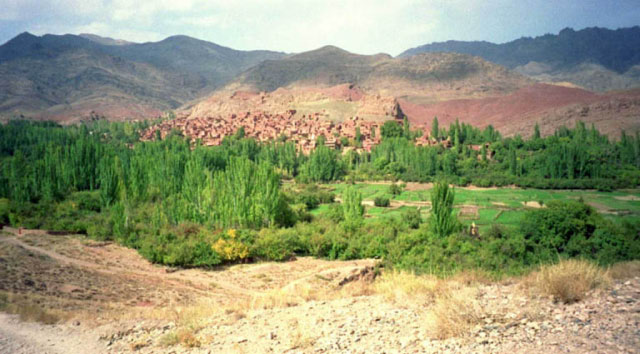
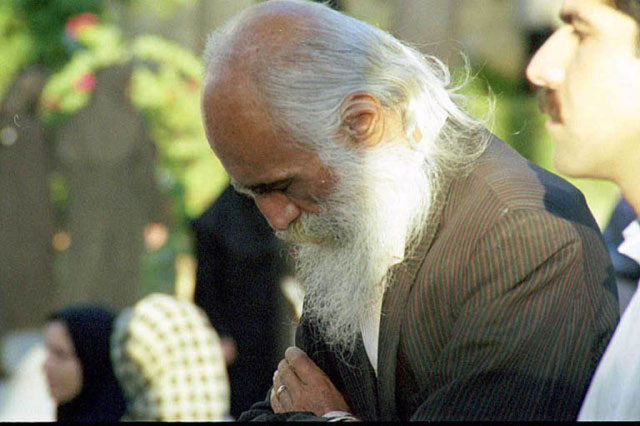
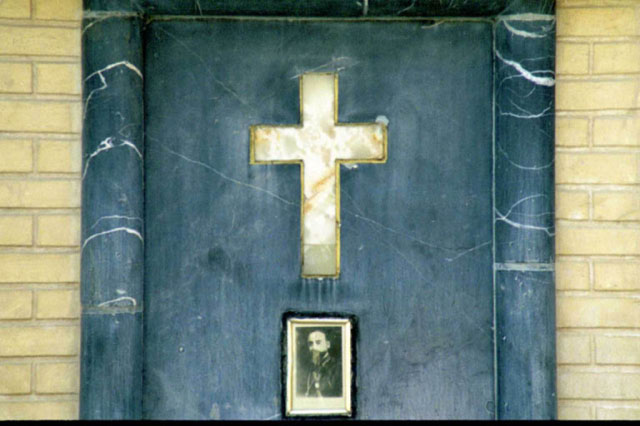
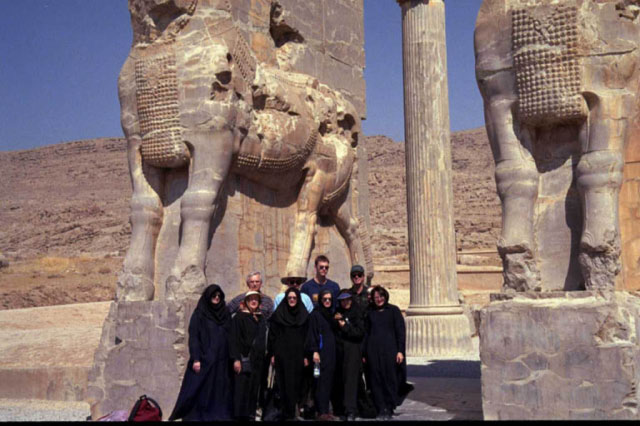
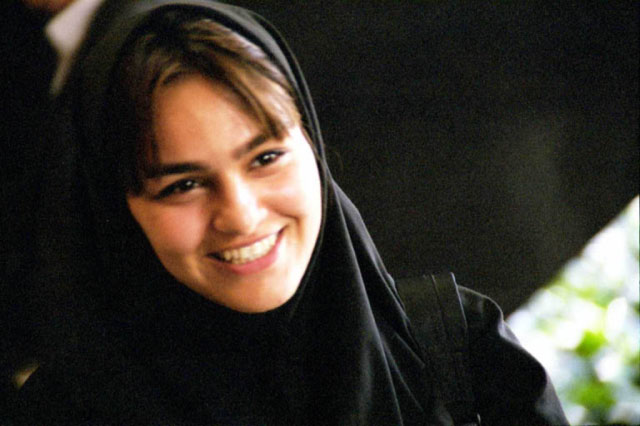 The schoolgirls at the carpet museum in Tehran who giggled like school-girls
everywhere; they followed our group around and requested pictures with the
group.
The schoolgirls at the carpet museum in Tehran who giggled like school-girls
everywhere; they followed our group around and requested pictures with the
group.